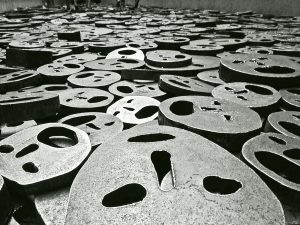 “The first cell felt no call to divide,” writes Sarah Lindsay in her poem Origin. Let me say that again:
“The first cell felt no call to divide,” writes Sarah Lindsay in her poem Origin. Let me say that again:
The first cell felt no call to divide.
Fed on abundant salts and sun,
still thin, it simply spread,
rocking on water, clinging to stone,
a film of obliging strength.
Its endoplasmic reticulum
was a thing of incomparable curvaceous length;
its nucleus, Golgi apparatus, RNA
magnificent. With no incidence
of loneliness, inner conflict, or deceit,
no predator nor prey,
it had little to do but thrive,
draw back from any sharp heat
or bitterness, and change its pastel
colors in a kind of song.
We are descendants of the second cell.
To put this into the language and dialectic of Tarot, we might say that the first cell was Upright. As we imagine the Universe, or God, or Life to be: in and of itself complete. Upright and maybe something akin to“perfect”, to use that blameless and indefectible language of spirituality. The second cell however, brought a kind of Reversal into this world: a walking, talking, plotting, murdering, christmas shopping till we be dropping primate reversal, a very human animal reversal if you like.
The first cell, that ne plus ultra of singularity, might be seen as representing an externally expressed energy. When one adds another cell into the mix, we go within: manifesting as internalised energy, the two cells engaging with each other, cheek by jowl, in what we might call an inner “life”, which for us revolves mainly around our human psyches.
And with that inner engagement, we also get conflicts and reversals which all add up to what we now call “the whole”. Upright and Reversed co-existing in one organism: the inner and outer, the persona as well as its more expansive, more ductile “soul” or inner world.
Carl Jung’s favourite Greek philosopher was Heraclitus, who wrote in one of the few fragments we still have of his work:
What was cold soon warms, and warmth soon cools. So moisture dries, and dry things drown.
And in another fragment:
What was scattered gathers.
Is that not too a wonderful notion of a human soul. What was scattered (scattered thoughts, perceptions, conflicting attitudes) gathers, becomes some kind of “whole”. What was warm (with passion, or anger) will invariably cool, and vice-versa. How could it be otherwise?
It was from Heraclitus that Jung took the idea of enantiadromia, from the Greek enantios meaning “opposite” and dromos a racetrack. The first cell runs in only one direction (externally we might say, in the direction of seeing and perceiving, of consciousness), the second cell runs in another direction (internally, on tracks or those scattered, trackless paths we call the unconscious), but they invariably do meet, as Paul (McCartney) seemed destined to meet John (Lennon). Or Werner (Herzog), Klaus (Kinski).
“I use the term enantiodromia,” Jung writes in Psychological Types, “for the emergence of the unconscious opposites in the course of time. This phenomenon occurs when an extreme, onesided tendency dominates conscious life; [and thus] in time an equally powerful counterposition…breaks through.”
To put it simply: everything is in a state of flux and everything at some point turns into its opposite. Everything is eventually balanced or “compensated” for, in time, by its polar opposite, the inverse and the obverse settling some cosmic score, if you like. We see this happening on our planet at the moment with extreme weather events and plagues countering the devastation we have wreaked since we started extracting and burning fossil fuels and other resources as if we were deities rather than just a weird kind of hairless ape intent on shopping till we truly be dropping. I am recording this episode on Black Friday, a truly funereal day for humanity, even whilst Amazon tries to cash in on Black Lives Matter with marketing images for the day on its homepage of bourgeois black folk entering the paradise of white privelege through the eye not of a needle, but through the neverending, one might say hellish pit of waste and consumption spurred on by Amazon Prime ease of purchase.
In some fundamental way, opposites are engendered, in our human animal psyches right from the start. We are all hung out to dry on a cross built on pleasure as well as pain, insight as well as ignorance, kindness but also meanness. There is no keeping the one and dispensing with the other. For we are descendants of the second cell.
In this episode where I hope to explore the Upright versus Reversed Fool, I’m going to let you make that distinction yourself dear listener, or refrain from doing so, if you prefer. Benign fool, malign fool, something in between, you decide.
EXHIBIT ONE: ZARMARUS
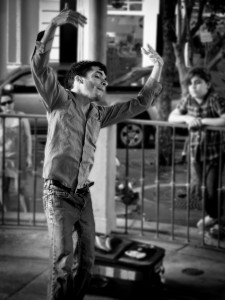 Our first fool. Zarmarus who lived around the time of Christ. Here is his story, as related by Judith Schalansky in her book An Inventory of Losses:
Our first fool. Zarmarus who lived around the time of Christ. Here is his story, as related by Judith Schalansky in her book An Inventory of Losses:
“It is reported that the gifts presented by the Indian delegation that Augustus once received on the island of Samos included not only a tiger and an armless youth who was able to use his feet as hands, but also a man named Zarmarus from the Brahmin caste who was intending to end his own life for the very reason that it had turned out the way he wanted. To make quite sure that no calamity could ever befall him, he leaped onto the pyre in Athens, naked, anointed, and with a smile, was burned alive, undoubtedly in excruciating pain, and in staging his self-determined death, went down in history, if only as a curious anecdote in one book of Cassius Dio’s once eighty-volume Roman History, the content of which happened to be passed down to us. In the end, all that remains is simply whatever is left.”
What impression is left in your mind after hearing about Zarmarus?
Here are some “upright” words often associated with the Fool archetype: beginnings, innocence, spontaneity, crossroads, journeys, ideas, happiness, laughter, trust, instinct, intoxication, creativity, potential, renewal, leaps of faith, carpe diem, living-in-the-moment, fearlessness, awe and curiosity, fresh perspectives.
Do these align with Zarmarus. Of course they do.
And here are the reversals, the antonyms where we see the archetype from another angle, maybe even from a 180 degree angle, as the shadow side of all this foolish ra-ra bubbles up from the depths of the unconscious: naivety, recklessness, entitlement, immaturity (but also a kind of stultifying maturity), vanity, apathy, anxiety, mania, spiritual materialism, hysteria and even delirium.
Zarmarus? Yes, him too.
Lame Deer, a North American Indian shaman, explains uprights and reversals as exemplified in our foolish selves like this:
[The ’sacred clown’, that contrarian, jester, and satirist, who speaks, moves and reacts in an opposite fashion to the people around them] in our language is called a heyoka. For they are often upside-down, backward-forward, yes-and-no, contrarywise. Everybody can be made into a fool, from one day to another, whether they like it or not. It is very simple to become a heyoka. All you have to do is dream about lightning and thunderbirds. You do this, and when you wake up in the morning you are a heyoka. There is nothing you can do about it.
There is nothing you can do about it. I think what this means is that there is a somewhat determined, fated, even fateful quality to the Fool’s path, as well as to all paths of folly. Which is a paradox, for the fool archetype might also represent to some extent the fantasy of Free Will In Action. Perhaps only as Fool can we throw ourselves into grand plans dreamed up on a whim in the bath. Into writing novels, or podcasts, or music albums, or fighting climate change, or slavery, or any foolish reversal of the status quo. Even though as Fools, we might not be best placed to carry out those plans, and may in fact screw things up on a small as well as grand scale.
EXHIBIT TWO: JOSHU
 Let’s stick with the Buddhists for now, and one of my favourites, the Zen monk Joshu who was born and lived in Northern China from around 778 to 897 AD.
Let’s stick with the Buddhists for now, and one of my favourites, the Zen monk Joshu who was born and lived in Northern China from around 778 to 897 AD.
The following two incidents come from Yoel Hoffman’s book Radical Zen: The Sayings of Joshu.
One of Joshu’s monks asks him, “To be holy—what is it like?”
Joshu replies, “What is it like? It is like dumping a mountain of shit on a clean plain.”
The monk is not sure what to say, but after some moments asks for further clarification.
Joshu replies, “Stop fucking with my head.”Another monk asks, “Master Joshu, What is ‘holy’?”
Joshu replies: “Ordinary.”
The monk asks a follow-up question: “So what is ‘ordinary’?”
Joshu replies: “Not holy.”
EXHIBIT THREE: EROS
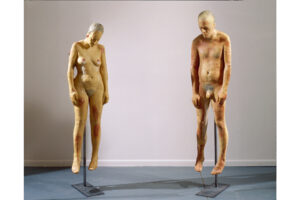
Which is to say: human animals in various permutations flirting with each other. But in this case, in particular: heterosexual men hitting on women. Once again, I give you this fool, first heard at the end of episode two, who believes that because his waitress Linda is being friendly towards him, she might be angling for a boyfriend, or at the very least, to have his genital organs sliding around inside hers.
[Excerpt from Date Night (cf. audio in podcast)]
At the end of an incredibly illuminating discussion about feminism with Julie Bindel on her Honesty podcast, the journalist Bari Weiss asks Bindel to reflect on the animal at the core of this human animal, we call (small caps) man.
[Excerpt from Bari Weiss conversation with Julie Bindel (cf. audio in podcast)]
EXHIBIT FOUR: MY BROTHER
 Whilst preparing this piece on the fool, I get a phonecall one morning from my mother to tell me that my brother has put his back out again. My brother has been struggling with lower back pain for almost a decade now. Every couple of years he’s consigned to bed for a few weeks, but he also spends a lot of time lying on the floor of editing suites (he makes TV programmes), or train stations, or airports, or the rooms of his house unable to stay upright without a great deal of discomfort. I have had my own brushes with lower back pain, but nothing compared to what my brother has gone through.
Whilst preparing this piece on the fool, I get a phonecall one morning from my mother to tell me that my brother has put his back out again. My brother has been struggling with lower back pain for almost a decade now. Every couple of years he’s consigned to bed for a few weeks, but he also spends a lot of time lying on the floor of editing suites (he makes TV programmes), or train stations, or airports, or the rooms of his house unable to stay upright without a great deal of discomfort. I have had my own brushes with lower back pain, but nothing compared to what my brother has gone through.
He has attempted self-cures with pilates, and pain-killers, and physio, but his work is sedentary and no doubt puts a good deal of strain on his spine (ten to fifteen hours a day leaning forwards in front of a computer screen). He has never been much of a fan of regular exercise, and is carrying a fair amount of extra weight. He also has two young children and is the main breadwinner for his family.
This week was the worst episode so far. Putting on his trousers, he felt and heard a ripping and a tearing in his lower back, and for the first time ever, not only yelped, but screamed in agony as he fell to the floor, all six foot two of him, crashing down. Unable to move, he pulled the duvet off the bed where his phone had been left and called for an ambulance. They wouldn’t come because they assessed him as not dying, and welcome everyone to the post-pandemic NHS, that once great, envied by all healthcare institution, which is now also lying flat on its back like a beached whale, slowly expiring. My elderly parents went over to see if they could help. When he tried to pee into a bottle his back suddenly went into spasms. He screamed again and again, grabbing hold of my father’s hand as if he were about to tear it off at the wrist. The pain excruciating. I cannot even imagine that pain. My mind shuts down as I try to imagine his pain.
After some hours, the paramedics arrive and it takes copious quantities of gas and morphine, and even more grinding physical pain to get him down the stairs and out of the house into a hospital, where the Kafkaesque shenanigans continue as he’s shunted between A&E (Accidents and Emergency) and ED (the Emergency Department), never making it into the hospital itself after an MRI reveals that his spine is bulging, but probably won’t cripple him in the next 24 hours. So nothing can be done for my brother by the once-great NHS, and in fact he must now leave, even though he can hardly walk or sit without vast amount of morphine, diazapam, codeine screening the body’s plight.
Throughout it all, certainly from the stance his wife takes towards him, I detect frustration that he has let this drag on for so long without “turning his life around”, losing weight, getting fit, making his work set-up more ergonomic. All that post-hoc self-recrimination and crepuscular blame from others that goes on when tragedy strikes and our minds tell us that if we’d only done this or that, our pain and suffering might have been avoided. And yet, whatever fool he has been, and will continue to be, this foolishness is something we all do. I didn’t go to the dentist for a decade after an unpleasant root canal treatment. Avoidance, procrastination, burying our heads in the sand and refusing to see or tackle what is self-evident to everyone else, this is our bread and butter foolishness as far as the human animal species is concerned. Which is what makes those who throw their stony little tweets at everyone else who has failed them or themselves on a daily basis, a deliciously sad and farcical affair. We’re all living in glass houses. And those glass houses are sometimes called “our bodies”. [crash]
EXHIBIT FIVE: HERZOG/KINSKI
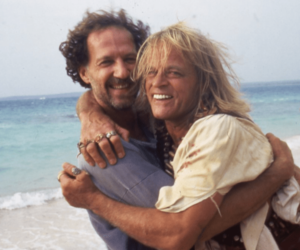 That is to say: the film maker Werner Herzog, and his “muse”, for want of a better word, Klaus Kinski.
That is to say: the film maker Werner Herzog, and his “muse”, for want of a better word, Klaus Kinski.
So I thought it might be fun to watch Werner Herzog’s Fitzcarraldo, a film I have always known about, but never seen. And while I was at it, why not also download the Les Blank documentary about the making of Fitzcarraldo called Burden of Dreams.
If you don’t know Klaus Kinski who plays the eponymous fool in Fitzcarraldo, imagine a skinnier even more demented version of Boris Johnson: Boris Johnson as creepy, sex-crazed leader of a millennial cult. In the role of Brian Sweeney Fitzgerald, known to the Peruvian natives as Fitzcarraldo, Klaus Kinski as Fitz has the cock-eyed plan of dragging a three-story, 320 ton steamboat up an incredibly steep hill in order to access a grove of rubber trees which might he hopes make his fortune. The film is based on the story of Carlos Fermin Fitzcarrald, a real life rubber baron who at the height of the Amazon Rubber boom (1879-1912), disassembled a boat and had it carried in pieces across an isthmus from one river to the next.
What drives Fitzcarraldo for the most part however is not what drives Johnson (sex, power, money – most likely in that order), but a more foolish kind of striving within the realm of “art”. For Fitz is obsessed with opera, and would like to use his rubber earnings to build an Opera House in Iquitos, a small city, East of the Andes, in the Amazon basin. In some way, although portrayed as a kind of get-rich-quick entrepreneur, he is also aligned with the the archetype of the artist or creative: the visionary fool who struggles to explain to those around them their need to manifest their life energies in this way. “There’s a thread you follow”, writes the poet, William Stafford, “It goes among / things that change. But it doesn’t change.”:
People wonder about what you are pursuing.
You have to explain about the thread.
But it is hard for others to see.
While you hold it you can’t get lost.
Tragedies happen; people get hurt
or die; and you suffer and get old.
Nothing you do can stop time’s unfolding.
You don’t ever let go of the thread.
Attending a party hosted by Don Aquilino, the rubber baron who eventually sells him the steamboat with which he will attempt this seemingly impossible feat, Fitz is unamused, maybe even disgusted by the conspicuous consumption and grandstanding he witnesses, such as when Don Aquilino drops a handful of cash into his carp pond, to show how even the fish have developed a taste for filthy lucre. At one point in the proceedings, Fitz tries to win the assembled financiers and entrepreneurs over to his side by playing them a song from Meyerbeer’s 1865 opera, L’Africaine, itself a kind of veiled commentary on issues of race, religion, slavery, and colonialism. For the gathered imperialists, Fitz decides to treat them to a 1907 recording of Enrico Caruso singing O Paradiso, itself a kind of hymn to impossible possibilities; perhaps also a rallying cry for that god-given birthright of the white man to colonize and monetize as much of the earth as he can. Although thankfully we now have a much more equal opportunities, Benetton affair in place when it comes to the pillaging of natural resources, China and India now getting into the act, and no doubt in the next few decades perhaps taking over the white man’s achievement of being Chief Desecrator of All He Surveys.
O paradise, emerging from the sea, wails Caruso.
Flowering earth, brilliant sun,
You entrance me!
You belong to me!
This is perhaps one of the most touching as well as amusing scenes of the film. Kinski beaming in evangelical delight and self-satisfaction as the keening of Caruso struggles to to cut through the chatter of the partygoers, some looking over with a modicum of tolerance, others blatantly ignoring him; the whole matter treated as a kind of embarrassment, as opposed to a conversion practice. We see the Fool’s intensely vulnerable desire to have his obsession, his religion you might say, vouchsafed by the attention and admiration of others. Kinski embodies the fool in this film, but perhaps in all the Herzog/Kinski films, in their purest, most child-like state, painfully earnest and enthused by their desire to draw others into their obsessive pursuits.
In Burden of Dreams, the documentary made to honour the trials and tribulations that went into the making of Fitzcarraldo, we begin to see parallels between the story of Fitz and Werner Herzog’s own Sisyphean dream to capture on celluloid these event, as well as the many topsy-turvy setbacks he and his crew faced in filming this story, mirroring problems that his central character also has to grapple with: most notably the mechanics of dragging that 300-ton steamer up the hill, as well as the sometimes fraught dealings and negotiations with indigenous tribes of the region. Above all, the seemingly indomitable spirit of Herzog and his crew in keeping this messy invention afloat, translating it from a script (written in three days by Alan Greenberg from notes sent to him by Werner Herzog), into human animals and their natural world interacting in that play of light we call cinema.
It becomes clear watching the documentary that Herzog and Kinski are two sides of the Fool archetype. Put simply: the Pro-Social Fool, who for the most part is externally focused on the world and others, versus the Anti-Social fool, introspectively and introvertedly curdled from within. One of these (Herzog perhaps) pursues his dreams and obsessions with a certain kind of conscientiousness, a sort of ethical underpinning – as an Apollonian Fool, we might say, to use that Nietzchian distinction. While the other fool, Kinski, unless manifesting in ecstatic as well as narcissistic (all eyes on me) performativity of his life-force, is by and large the epitome of an impatient, restless, testy and testing, Dionysian anarchist.
There is something inherently noble about the Herzog-like Fool, who gets knocked down over and over, but still manages to get up again, to keep calm and carry on. Herzog is the quintessence of keep calm and carry on in almost every scene we witness, whereas Kinski is a paragon of turbulence and chaos. This is best captured when we see Werner Herzog speaking to camera about the devastating blow visited on the project after his initial lead actor, Jason Robards, was forced through dystentry contracted on set to bow out of further filming, even though 40% of Fitzcarraldo had already been shot by this point:
[cf audio in podcast for quote: HERZOG “I live my life, or I end my life with this project”]
Compare this with Robard’s replacement, Kinski, and his protracted disgruntlement about how boring he finds it consigned to a camp in the jungle with nothing nothing else to do but read, eat, drink, play and make films. Oh how the heart bleeds for his struggles!
[cf audio in podcast for quote: KINSKI: “This fucking thing”
In his autobiography, Kinski dubs Herzog as “a miserable, hateful, malevolent, avaricious, money-hungry, nasty, sadistic, treacherous, cowardly creep.”
He continues.
“His speech is clumsy, with a toad-like indolence, long-winded, pedantic, choppy… I’ve never met anybody so dull, humourless, uptight, inhibited, mindless, depressing, boring and swaggering.”
Herzog has always explained away this tirade by saying that the two had cooked up the offending passages together: “Kinski came to me and said that he had to write bad things about me, that is what his filthy readers wanted. I even supported him in finding even viler and fouler and baser expletives. I would come to his place with the dictionary and thesaurus and together we would take the page of invective and make it more colourful.”
This may be true, but I also find it interesting that Kinski assigns adjectives to Herzog that are far more applicable to KK himself. It is an illuminating example of projection. For does not all projection manifest as an extension of our shadowy selves, those parts of us that may be known to others but obscure to our own metacognition, or perhaps the blindness resides in both of us? Think about those unconscious perceptions which fester in our minds, irritating our complexes when we get even a whiff of them in others, thus causing us to attempt a kind of distancing, an excommunication, or even exorcism of this part of our own psyche, by transposing or painting it over someone else’s in our own “miserable, hateful, malevolent, avaricious, money-hungry, nasty, sadistic, treacherous, and cowardly” way.
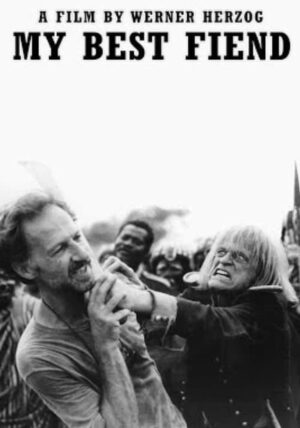 Herzog would also made a documentary about Kinski 18 years after the filming of Fitzcarraldo, and almost a decade after Kinski’s death in 1991. He called his ambivalent tribute My Best Fiend (get it?), and it goes into some depth about his troubled but persisting relationship with KK whose destiny was inextricably intertwined with his own through the making of five strenuous films and a thousand interpersonal clashes.
Herzog would also made a documentary about Kinski 18 years after the filming of Fitzcarraldo, and almost a decade after Kinski’s death in 1991. He called his ambivalent tribute My Best Fiend (get it?), and it goes into some depth about his troubled but persisting relationship with KK whose destiny was inextricably intertwined with his own through the making of five strenuous films and a thousand interpersonal clashes.
If one were in any doubt about the violent and often bloody outcome of Kinski’s volatile mental health, My Best Fiend crushes any romanticism we might wish to sustain around the myth of Klaus Kinski. The most shocking stories are of his barbarism, there isn’t really another word for it, towards the indigenous people who played the Extras in those films: the metaphorical and literal footsoldiers of Aguirre, and Woyzeck, Fitzcarraldo and Cobra Verde. Herzog interviews some of those extras who had their heads caved in, or were attacked, even fired at at when Kinski got a little bit too carried away on and off set.
The documentary opens with a scene of high comedy, almost buffoonish comedy, the Fool seen at his most charmingly eccentric but also most deranged. Herzog and his camera crew visit the boarding house in Munich where he lived for three months at the age of 13 with his mother and older brother Tilbert. The broken down boarding house has in the intervening years become supremely gentrified, and is now a palatial flat owned by the Baron and Baroness von der Recke.
Herzog in the persona of genial, affable fool, upbeat fool, avuncular fool, the fool as kindly therapist with a twinkle in his eye, relates that it is in this boarding house that he first met his friend, his fiend, his hall-of-mirrors reversal: Kinski, this human animal who would become in time Herzog’s psychic shadow, his foul-mouthed, malevolent, avaricious, nasty, sadistic, cowardly, swaggering doppelganger for the next fifty years.
“The owner of the boarding house,” he patiently explains to the equally polite and expensively tailored Baron and Baroness, “was an elderly lady of 65 with wildly dyed orange hair called Klara Reith who, had a soft spot for starving artists as she herself had come from a family of artists. Kinski had been living nearby in an attic, without furniture just bare beams, and everything covered knee-high with dead leaves. He posed as a starving artist and walked around stark-naked.”
“Oh yes?” the Baron says in a tone of one who is possibly regretting at this moment his decision to allow himself and his elegantly attired wife to be participants in Herzog’s film about Kinski.
“Yes, goes on Herzog, almost gleefully. “And when the postman rang. Kinski rustled through his leaves, stark-naked, and signed.
“But he wore clothes when he lived here, I hope?” the blue-blooded Baron hesitantly enquires.
Herzog then explains that Kinski would lock himself in this bathroom for two days and two nights. In this time, in a maniacal fury, he would smash everything to smithereens. The bathtub, the toilet bowl – everything. “You could sift it all through a tennis racket,” he relates, as if describing the some feat of wonder performed by a highly intelligent ape.
Herzog continues to set he scene: “It was really incredible. I never thought it possible that someone could rave for 48 hours. They called the police in the end, but they left him in peace. And then one day, Kinski took a huge running start down the corridor while we were eating. I heard a strange noise and then in an explosion the door came off its hinges crashing into the room. He must have jumped against it at full speed, and now he stood there flailing wildly, completely hysterical, snow-white in the face. He was foaming at the mouth, and something came floating down like leaves -they were his shirts his screams were incredibly shrill. He could actually break wine glasses with his voice. And three octaves too high he screamed, ‘Klara! You pig!’ The thing was, she hadn’t ironed his shirt collars neatly enough. Klara had him living here for free, fed him and did his laundry. But to no avail. One day a theatre critic had been invited for dinner. He hinted that having watched a play in which Kinski had a small role he had decided to mention him in his review as outstanding and extraordinary. At once, Kinski threw two hot potatoes and the cutlery into the critic’s face, jumping up and screaming: “l was not excellent! I was not extraordinary! I was monumental! I was epochal!” All this made a very deep impression on me then,” the 13 year old Herzog admits through the mouth of his 57 year old self.” And then, as if he can’t quite believe his own foolishness: “To think that I would work with him later and make five feature films!”
“You would never have thought,” the Baroness at this point pipes up from her manicured finery.
“No, that was never on my horizon at the time,” Herzog admits, still surprised even now as to what has passed in the collaborative interactions of these two fools. “It was beyond my wildest dreams.”
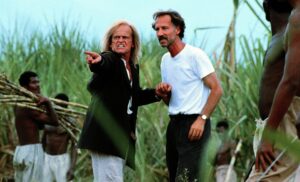
Something is being worked out at a psychic level no doubt in the five films that the upright fool made with his shadow. Each of them are in some way a commentary on Kinki’s not so unique, monumental or epochal animal human insanity. Aguirre, Wrath of God (1973) is a study of megalomania and domination by brutal, even sadistic force embodied in Kinski. In Nosferatu (1979) Kinski is a vampire who longs for acceptance from the people he terrorizes. In Woyzeck (1979) he plays another outsider, who is driven to abase himself for the love of his wife and child, but this love also suffers a profound reversal ending in tragedy. Three years later, he’s back for Fitzcarraldo, and in the final film they made together, Cobra Verde (1987) where he plays a slave-trader who descends into the by now, archetypal Kinski terrain of madness and self-destruction.
How might we understand the relationship between the reversed fool and his upright doppelganger? Perhaps the writer and psychiatrist Ian McGilchrist, gives us one of the best ways to make sense of this, by focusing on where some of this division undoubtedly stems from, our divided human animal brains.
“What I found was the differences [between the two hemispheres] was not to do with what they did in terms of reason, language etc. But how they approached everything. The differences were in the manner of approach. And that brought me to the question of attention, because attention is how we dispose. From an evolutionary point of view. The basis for this is an evoltuinary need to do two entirely different things at once. One is a narrow, detailed, highly focused. In order to get it. In order to get food, pick up a seed. To manipulate the environment for your own good, you need a certain. But if that’s the only attention you pay, the whole of the world. And that’s extremely danger. In order to survive, you need to pay two kind In a soundbite, I say the Left Hemisphere is designed to help us manipulate the world, the Right Hemisphere to understand it.”
In this distinction, Kinski (and perhaps all fools in their reversed states) is the Left Hemisphere, aka The Manipulator: who will stop at nothing to get our specific needs met in whatever way we see fit.
McGilchrist’s overarching theme in his books The Master and His Emissary and The Matter With Things is that the human species as a whole, especially in its Western, post-enlightenment iteration has become dominated by the Left Hemisphere’s focus of attention, resulting in the destruction of ourselves and our natural habitats, as well as in the maltreatment and desecration of other human animals to get our shiny electronic toys, fashion items, and other playthings produced.
And even more perhaps, in the holocaust we visit upon the non-human animal world each day to feed our desire for anthropocentric domination, as well as our love of salty flesh and blood. For is not our manipulative Left-Hemisphere Fool driven first and foremost in its object-seeking by what Freud termed our libidinal drives, the search for something to put in our gobs or to stimulate our erogenous zones? And how can we not in this pursuit render (which is to say objectify) almost everything we come into contact with as if they were just things, objects, placed here on this planet for our personal use and satisfaction. All the evidence you need for this assertion within the realm of sexuality can be found on pornhub, and by the very fact that porn rather than poetry drives technological innovation. But what about that other bodily need? Consider that yesterday, whichever yesterday you have in your awareness at the moment, we (us human animals) killed 826 917 cattle for our spaghetti bolognese and hamburgers.That’s almost a million non-human animals from just one species of cloven-hooved herbivores dispassionately slaughtered to satisfy our taste for flesh. And that was just yesterday.
Also, in the last 24 hours, 1 186 484 fish were clobbered or asphyxiated for a dish of paella, or good old fashioned fish and chips. And an almost equal number of sheep (1 496 150) for comfort food such as shepherd’s pie and lamb vindaloo.
The Jews, some of my family included, still to this day wear sackcloth and ashes for the six million killed in the last century by Hitler and his gang. The Jews do not wear sackcloth and ashes for the 4 106 589 pigs killed in just the last twenty four hours for bacon butties and BBQ pulled pork, some of which we too, especially in our secular manifestations, have eaten and enjoyed. We Jews would certainly not wash our hands with soap made from fat drained off incarcerated, gassed, and burnt bodies at Auschwitz or Birkenau, but we don’t say no to non-human animal products, do we? All we need are our rabbis and our Food Standards Agency (the FSA as it is known in the UK) to deem that this mass slaughter is hygeniec in terms of consuming the flesh of the dead, and hey presto as if by magic, all that pain and destruction gets hidden away so that we can go shopping and feed our faces. And even though we have plant substitutes now for all our comfort foods, we rampage on don’t we, Klaus-Kinski like, with a big fuck you to pretty much everyone and anyone who even dares raise an eyebrow at the aisles of dead flesh that make up our supermarkets. Instead, we respond to this cognitive dissonance, with clever and sophisticated self-serving language that emanates from our left-hemisphere dominated brains. Control, procure, manage, manipulate, dominate, punish, proliferate, accumulate, aggrandize, and in whatever way you can, in culture, or business, or politics, make a killing; this is how we roll as human animals. Welcome to world of the apex predator, homo sapiens sapiens, aka you and me dear listener. You and me.
Werner Herzog in this analogy perhaps represents more that fool on the hill of the Right Hemisphere, whose raison-d’etre is slightly more inclined towards integration, incorporation, individuation, and understanding rather than the more shadowy reversals of the butcher and the restaurant critic supping on plates of dead flesh with much smacking of lips and clever commentary. This Fool’s attention, the Right Hemisphere Fool, is somewhat more focused on relational connection, on not just the parts but the whole, on what is new rather than what is known, on possibility rather than certainty, on flux and change as opposed to fixity and stasis, on viewing phenomena from implicit, context-embedded perspectives rather than decontextualised, explicit dogma; on seeing things as they are pre-conceptually -fresh unique and embodied -rather than as representations (literally re-presentations) after the fact.
But perhaps most importantly: these two fools need each other, and also balance out each other in some way, as long as one doesn’t get the upper hand.
The first cell felt no call to divide. No call to kill, to dominate, to manipulate. But we are descendants of the second cell, and therein lies both our glory as well as our (possibly) gory end. L’chaim!
